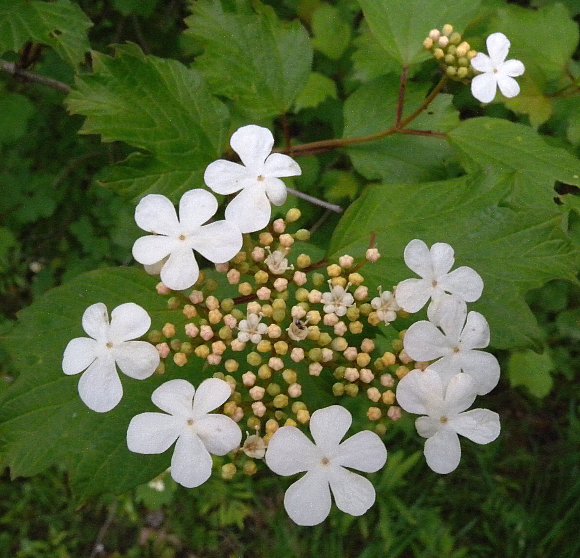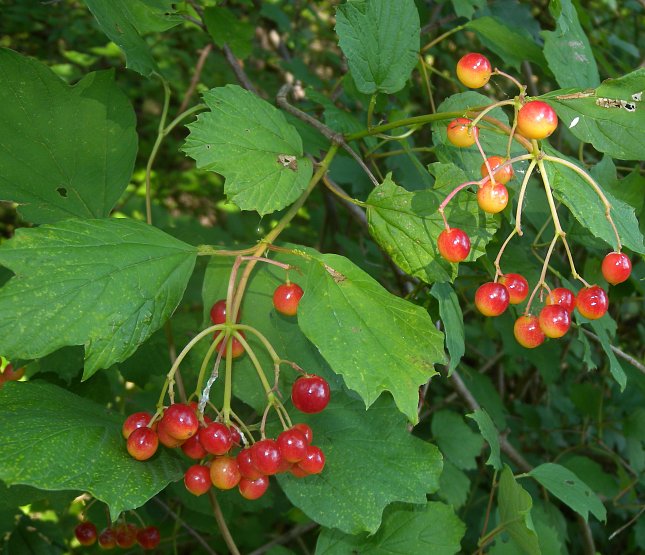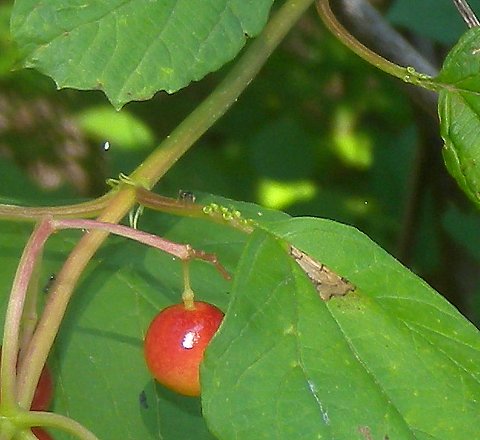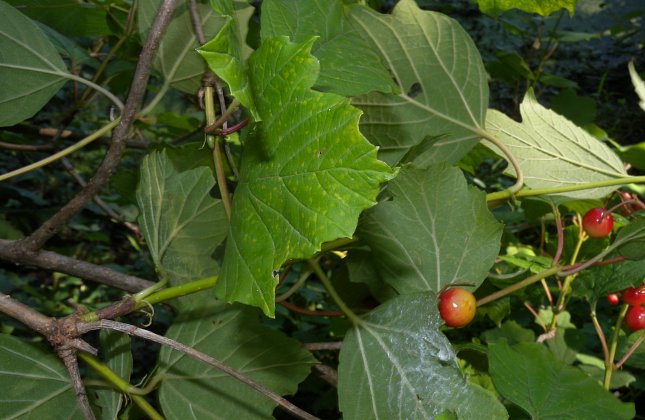Eurasian Cranberry Bush
Viburnum opulus
Honeysuckle family (Caprifoliaceae)
Viburnum opulus
Honeysuckle family (Caprifoliaceae)
Description:
This is a branched deciduous shrub; it becomes 4–16' tall at maturity
and similarly across. The bark of older branches is gray or brownish
gray and slightly rough, while younger branches are brown, terete, and
smooth with scattered white lenticels. Young shoots are light green or
reddish green, terete, and smooth. Pairs of opposite leaves occur at
regular intervals along the younger branches and shoots. These leaves
are 1½–3½" long and similarly across; they are broadly ovate,
orbicular-ovate, or orbicular-obovate in outline, but with 3 shallow to
moderately deep lobes and coarsely dentate margins. The upper leaf
surface is yellowish green to medium green and hairless, while the
lower leaf surface is whitish green, pubescent along the major
veins, and usually sparsely pubescent between the veins. Leaf venation
is palmate at the base (each lobe of the leaf has a central vein),
however secondary veins along the central veins of the lobes are
pinnate. The petioles of the leaves are ½–1½" long, light green to red,
and narrowly grooved along their upper sides. Near the base of each
leaf, the petiole has 2–4 (or more) small nectary glands that that have
upper sides that are short-oblong to oblong in shape and concave;
laterally they are more or less straight-sided.

Young shoots terminate in compound cymes of flowers spanning about 2–4" across. The stalks and pedicels of this inflorescence are light green to reddish green, terete, and hairless. Along the outer margin of the compound cyme, there are 5–10 sterile white flowers, while the interior of the cyme has many fertile white or cream-colored flowers that are smaller in size and crowded together. Each sterile flower is about ¾" across; its corolla has 5 rounded spreading lobes and a very narrow elongated tube below. Each fertile flower is about ¼" across or a little less; its corolla is campanulate (bell-shaped) with 5 small lobes that are spreading to recurved. Each fertile flower also has a very short tubular calyx that is green and hairless, 5 exserted stamens, and an ovary with an inserted style. The blooming period occurs from late spring to mid-summer, lasting about 3 weeks. Fertile flowers are replaced by fruits that develop during the summer and become mature during autumn. At maturity these berry-like fruits are about 7–10 mm. long, ovoid-globoid to globoid in shape, and hairless; they turn yellow at first, finally becoming red. The interior of each fruit contains a single large stone (seed with a hard thick coat) that is 6–9 mm. long, somewhat flattened, and ovoid in shape. The flesh of the fruit has a bitter and unpleasant taste. The root system is woody and it doesn't form clonal offsets from underground runners. The deciduous leaves of this shrub become reddish during the autumn.

Cultivation: The preference is full sun to light shade, wet to mesic conditions, and rich soil containing organic matter with an acidic to neutral pH. Sandy soil with organic matter is also acceptable. This shrub is very cold-hardy.
Range & Habitat: Eurasian Cranberry Bush (Viburnum opulus) occurs occasionally as a naturalized shrub in NE Illinois, while in the rest of the state it is uncommon or rare (see Distribution Map). However, this shrub will probably become more common in the future. In the United States, Eurasian Cranberry Bush is more common in the New England states and the Great Lakes region of the Midwest; it also occurs as a naturalized shrub in the Pacific Northwest and Canada. Eurasian Cranberry Bush was introduced to North America as an ornamental shrub, where it is still cultivated. There is a sterile cultivar of this shrub with only showy sterile flowers called 'Snowball.' It does not escape into the wild. In Illinois and the Midwest, Eurasian Cranberry Bush is found in such habitats as bottomland woodlands along lakes, moist thickets, edges of woodlands, fens, bogs, and roadsides. It is usually found in disturbed to average-quality natural areas, although it can become invasive in high quality wetlands in boreal areas.

Faunal Associations: The nectar and pollen of the fertile flowers attract primarily bees, flies, and beetles. This includes little carpenter bees (Ceratina spp.), Halictid bees (Lasioglossum spp. and others), and Andrenid bees (Andrena spp.). Fly floral visitors include mosquitoes (Aedes spp.), Syrphid flies (Temnostoma spp. and others), Tachinid flies, and Anthomyiid flies (Delia spp.). Beetle floral visitors include long-horned beetles, carpet beetles (Anthrenus spp.), and tumbling flower beetles (Mordella spp.); see Krannitz & Maun (1991) and Krombein et al. (1979). Insects that feed on Eurasian Cranberry Bush (Viburnum opulus) include the Viburnum Leaf Beetle (Pyrrhalta viburni), Black Bean Aphid (Aphis fabae), Viburnum Aphid (Aphis viburni), and Snowball Aphid (Neoceruraphis viburnicola). The larvae of a moth, the Rose Hooktip (Oreta rosea), and the larvae of a butterfly (later instars only), the Baltimore (Euphydryas phaeton), also feed on the foliage of this shrub (Wilhelm & Rericha, 2017; Blackman & Eastop, 2013; Pepper, 1965). The extra-floral nectaries on the petioles of this shrub attract miscellaneous ants (Wilhelm & Rericha, 2017). Some vertebrate animals also use this shrub as a source of food occasionally. Various birds, including the Cedar Waxwing, Northern Cardinal, Ruffed Grouse, Wild Turkey, and Ring-necked Pheasant, eat the fruits during autumn and winter (DeGraaf, 2002). White-tailed Deer browse on the foliage and twigs (ILPIN, accessed 2019).
Photographic Location: Photos of the fruiting shrub were taken in a bottomland woodland near a lake in Homer Lake Forest Preserve, Champaign County, Illinois, while the photo of the flowering shrub was taken along a roadside near Cowles Bog in Porter County, Indiana.

Comments: Eurasian Cranberry Bush (Viburnum opulus) has attractive foliage, flowers, and berries. It is very similar in appearance to American Cranberry Bush (Viburnum trilobum), so it is relatively easy to confuse them. They can be distinguished from each other by carefully examining and comparing their leaves and petioles. Eurasian Cranberry Bush has leaves with wider and more irregular lobes and it has more abundant coarse teeth along margins of its leaves. The leaf undersides of Eurasian Cranberry Bush tend to be more pubescent as well; this pubescence occurs not only along the major veins, but also between the veins to a lesser extent. The petioles of Eurasian Cranberry Bush are more narrowly grooved than the petioles of American Cranberry Bush, and the nectary glands on their petioles have different shapes. The glands of Eurasian Cranberry Bush have a more oblong shape with concave apices; they are sometimes more abundant as well. The glands of American Cranberry Bush are more columnar or tubercular in shape with apices that are flat or convex. Sometimes American Cranberry Bush is regarded as a variety of Eurasian Cranberry Bush, in which case the former shrub is referred to as Viburnum opulus americanum, while the latter shrub is referred to as Viburnum opulus opulus. The fruits of Eurasian Cranberry Bush reportedly have a less attractive flavor than those of American Cranberry Bush.

Young shoots terminate in compound cymes of flowers spanning about 2–4" across. The stalks and pedicels of this inflorescence are light green to reddish green, terete, and hairless. Along the outer margin of the compound cyme, there are 5–10 sterile white flowers, while the interior of the cyme has many fertile white or cream-colored flowers that are smaller in size and crowded together. Each sterile flower is about ¾" across; its corolla has 5 rounded spreading lobes and a very narrow elongated tube below. Each fertile flower is about ¼" across or a little less; its corolla is campanulate (bell-shaped) with 5 small lobes that are spreading to recurved. Each fertile flower also has a very short tubular calyx that is green and hairless, 5 exserted stamens, and an ovary with an inserted style. The blooming period occurs from late spring to mid-summer, lasting about 3 weeks. Fertile flowers are replaced by fruits that develop during the summer and become mature during autumn. At maturity these berry-like fruits are about 7–10 mm. long, ovoid-globoid to globoid in shape, and hairless; they turn yellow at first, finally becoming red. The interior of each fruit contains a single large stone (seed with a hard thick coat) that is 6–9 mm. long, somewhat flattened, and ovoid in shape. The flesh of the fruit has a bitter and unpleasant taste. The root system is woody and it doesn't form clonal offsets from underground runners. The deciduous leaves of this shrub become reddish during the autumn.

Cultivation: The preference is full sun to light shade, wet to mesic conditions, and rich soil containing organic matter with an acidic to neutral pH. Sandy soil with organic matter is also acceptable. This shrub is very cold-hardy.
Range & Habitat: Eurasian Cranberry Bush (Viburnum opulus) occurs occasionally as a naturalized shrub in NE Illinois, while in the rest of the state it is uncommon or rare (see Distribution Map). However, this shrub will probably become more common in the future. In the United States, Eurasian Cranberry Bush is more common in the New England states and the Great Lakes region of the Midwest; it also occurs as a naturalized shrub in the Pacific Northwest and Canada. Eurasian Cranberry Bush was introduced to North America as an ornamental shrub, where it is still cultivated. There is a sterile cultivar of this shrub with only showy sterile flowers called 'Snowball.' It does not escape into the wild. In Illinois and the Midwest, Eurasian Cranberry Bush is found in such habitats as bottomland woodlands along lakes, moist thickets, edges of woodlands, fens, bogs, and roadsides. It is usually found in disturbed to average-quality natural areas, although it can become invasive in high quality wetlands in boreal areas.

Faunal Associations: The nectar and pollen of the fertile flowers attract primarily bees, flies, and beetles. This includes little carpenter bees (Ceratina spp.), Halictid bees (Lasioglossum spp. and others), and Andrenid bees (Andrena spp.). Fly floral visitors include mosquitoes (Aedes spp.), Syrphid flies (Temnostoma spp. and others), Tachinid flies, and Anthomyiid flies (Delia spp.). Beetle floral visitors include long-horned beetles, carpet beetles (Anthrenus spp.), and tumbling flower beetles (Mordella spp.); see Krannitz & Maun (1991) and Krombein et al. (1979). Insects that feed on Eurasian Cranberry Bush (Viburnum opulus) include the Viburnum Leaf Beetle (Pyrrhalta viburni), Black Bean Aphid (Aphis fabae), Viburnum Aphid (Aphis viburni), and Snowball Aphid (Neoceruraphis viburnicola). The larvae of a moth, the Rose Hooktip (Oreta rosea), and the larvae of a butterfly (later instars only), the Baltimore (Euphydryas phaeton), also feed on the foliage of this shrub (Wilhelm & Rericha, 2017; Blackman & Eastop, 2013; Pepper, 1965). The extra-floral nectaries on the petioles of this shrub attract miscellaneous ants (Wilhelm & Rericha, 2017). Some vertebrate animals also use this shrub as a source of food occasionally. Various birds, including the Cedar Waxwing, Northern Cardinal, Ruffed Grouse, Wild Turkey, and Ring-necked Pheasant, eat the fruits during autumn and winter (DeGraaf, 2002). White-tailed Deer browse on the foliage and twigs (ILPIN, accessed 2019).
Photographic Location: Photos of the fruiting shrub were taken in a bottomland woodland near a lake in Homer Lake Forest Preserve, Champaign County, Illinois, while the photo of the flowering shrub was taken along a roadside near Cowles Bog in Porter County, Indiana.

Comments: Eurasian Cranberry Bush (Viburnum opulus) has attractive foliage, flowers, and berries. It is very similar in appearance to American Cranberry Bush (Viburnum trilobum), so it is relatively easy to confuse them. They can be distinguished from each other by carefully examining and comparing their leaves and petioles. Eurasian Cranberry Bush has leaves with wider and more irregular lobes and it has more abundant coarse teeth along margins of its leaves. The leaf undersides of Eurasian Cranberry Bush tend to be more pubescent as well; this pubescence occurs not only along the major veins, but also between the veins to a lesser extent. The petioles of Eurasian Cranberry Bush are more narrowly grooved than the petioles of American Cranberry Bush, and the nectary glands on their petioles have different shapes. The glands of Eurasian Cranberry Bush have a more oblong shape with concave apices; they are sometimes more abundant as well. The glands of American Cranberry Bush are more columnar or tubercular in shape with apices that are flat or convex. Sometimes American Cranberry Bush is regarded as a variety of Eurasian Cranberry Bush, in which case the former shrub is referred to as Viburnum opulus americanum, while the latter shrub is referred to as Viburnum opulus opulus. The fruits of Eurasian Cranberry Bush reportedly have a less attractive flavor than those of American Cranberry Bush.